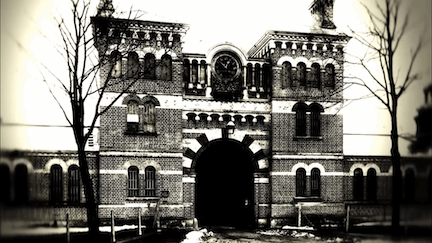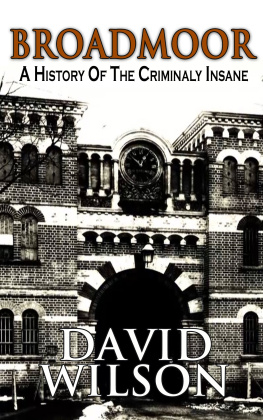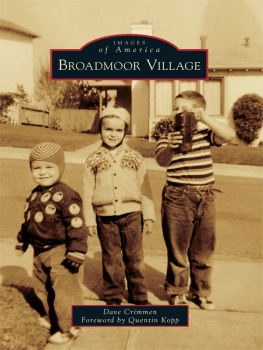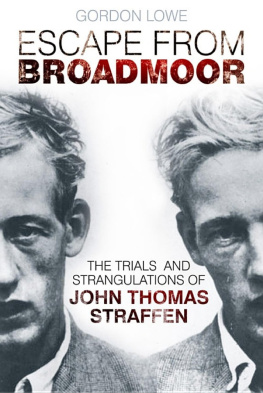David Wilson - Broadmoor: A History of the Criminally Insane
Here you can read online David Wilson - Broadmoor: A History of the Criminally Insane full text of the book (entire story) in english for free. Download pdf and epub, get meaning, cover and reviews about this ebook. year: 2018, publisher: Dreamscape Media, LLC, genre: Detective and thriller. Description of the work, (preface) as well as reviews are available. Best literature library LitArk.com created for fans of good reading and offers a wide selection of genres:
Romance novel
Science fiction
Adventure
Detective
Science
History
Home and family
Prose
Art
Politics
Computer
Non-fiction
Religion
Business
Children
Humor
Choose a favorite category and find really read worthwhile books. Enjoy immersion in the world of imagination, feel the emotions of the characters or learn something new for yourself, make an fascinating discovery.
- Book:Broadmoor: A History of the Criminally Insane
- Author:
- Publisher:Dreamscape Media, LLC
- Genre:
- Year:2018
- Rating:5 / 5
- Favourites:Add to favourites
- Your mark:
- 100
- 1
- 2
- 3
- 4
- 5
Broadmoor: A History of the Criminally Insane: summary, description and annotation
We offer to read an annotation, description, summary or preface (depends on what the author of the book "Broadmoor: A History of the Criminally Insane" wrote himself). If you haven't found the necessary information about the book — write in the comments, we will try to find it.
Broadmoor: A History of the Criminally Insane — read online for free the complete book (whole text) full work
Below is the text of the book, divided by pages. System saving the place of the last page read, allows you to conveniently read the book "Broadmoor: A History of the Criminally Insane" online for free, without having to search again every time where you left off. Put a bookmark, and you can go to the page where you finished reading at any time.
Font size:
Interval:
Bookmark:

Broadmoor Hospital: What images does that name conjure up for you a specialist medical facility offering professional help to people with underlying mental health problems? Or a place with a sinister past, synonymous with some of the countrys most notorious offenders?
Murderers, rapists, arsonists, pedophiles and child killers have all called the infamous asylum home.
The iconic hospital has housed some of the most notorious names in crime, from 1960s gangster Ronnie Kray, to the serial killers of today like Peter Sutcliffe, the Yorkshire Ripper; and Kenneth Erskine, the Stockwell Strangler.
The high walls keep us safe from those whod do us harm. But do we want Broadmoor Hospital to be more than simply a prison?
The Victorians used to be proud of Broadmoor. Its where the criminally insane got the best care and attention. Now 150 years later, it is shrouded in secrecy and seemingly on the verge of perpetual controversy.
David Wilson, a professor of criminology at Birmingham City University and a former prison governor, hosts this look at why this secure hospital, which opened in 1863, has become one of Britains most feared institutions.

Is the Broadmoor of the 21st Century a place of rehabilitation? Or somewhere to hide and control the worst elements of humanity?
Lobotomy, ECTs, sleep therapies and all that, were an attempt to deal with impossibly unwell people, an impossible group of deluded, hallucinated, troubled, haunted souls, said Dr. Trevor Turner, a psychiatrist with East London Foundation Trust.
Whether somethings a prison or a hospital depends on whos looking at it, and how you construct the people that go in it.
Today there are about 260 patients living in Broadmoor. The average stay is six years. Patients are sent to Broadmoor if they are deemed a danger to either themselves or members of the public. Some have committed crimes, whilst others simply present a high degree of risk.
But even inside the hospital, danger can still present itself to its more famous patients. The Yorkshire Ripper, Peter Sutcliffe, was sent to the institution in 1983 after brutally murdering 13 women. Hes still there today and has been attacked twice inside the hospital.
I think that unfortunately some of the people who were in Broadmoor in the mid-twentieth century to the late twentieth century have clouded the way that we think about the place, people like Peter Sutcliffe, and weve associated it with these legends of crime, says Elizabeth Yardley, professor of criminology and director of the Centre for Applied Criminology at Birmingham City University.
The story of Broadmoor raises so many questions about human nature and what the hospitals purpose really is. The Victorians built the institution out of a sense of social responsibility when our attitude towards the criminally insane was entirely different.
Before 1800, if youre mentally ill and youve committed a crime, youll either be found guilty, or you might be discharged back into your local community again, said Mark Stevens, an archivist and the author of Broadmoor Revealed. In 1800, everything changes, because of the very famous case a young soldier, called James Hadfield, took a potshot at George III.

Hadfield didnt fit societys impression of insanity, which at the time was seen as being brutish or infant-like. He was a 29-year-old ex-soldier who had found religion and had committed the crime purely so he could be put to death, avoiding the sin of suicide.
In order to detain Hadfield, the Criminal Lunatics Act was passed, allowing the government to send him to Bethlem Londons famous hospital for the insane.
As the nineteenth century wore on, the local asylums became extremely reluctant to take criminal lunatics at all, and indeed they were unwelcome in prisons as well, because it was felt that they disturbed other prisoners, said Dr. Harvey Gordon, a forensic psychiatrist and author of the book Broadmoor: An Inside Story.
Asylums such as Bethlem in London couldnt cope anymore with the increasing numbers of those deemed to be criminally insane. So in 1863, the government was forced to act and a new asylum was built Broadmoor.
It was a huge project covering over 280 acres in the Berkshire countryside just outside Crowthorne. There was one female block and a further five blocks for the men, 57 cottages for staff, cultivated land and even a school.
The asylum was built to contain people who were either, had been found not guilty by reason of insanity, so they were innocent of their crime, but they were felt to be too risky to be let at large into society; or prisoners who went insane actually while they were in jail, and required treatment in a hospital rather than continuing incarceration, Stevens said.
On the 27th May 1863, three coaches pulled up outside the newly built Victorian Buildings. Eight women and their escorts had arrived from Bethlehem hospital to make Broadmoor their home.
The first patient to be admitted was Mary Ann Parr, a 35-year-old labourer. Shed lived in poverty all her life and had what we would now call learning difficulties.
I seem to remember shes described as a woman of short stature, Stevens says, complains of pains in the forehead; teeth irregular and notched, she was described as having, which is a symptom of congenital syphilis; and then finally, shes described as being of very irritable temper. Then, when she was aged 25, shed had an illegitimate child. Shed had no real way of looking after the child, and had decided the best solution for it would be to suffocate it, which she did at her breast.
So she was actually convicted of murder, but there was, as there often was, some sort of public outcry its not fair, we cant hang her, shes not mentally responsibly responsible for her actions. So her death sentence was commuted and she was sent off to Bethlem instead where she remained for more than 20 years before going to Broadmoor.
How are we able to build up such a detailed picture?
The interesting thing about English asylums is, a lot of them seem to have been fantastic record-keepers, and Broadmoor is no exception, Stevens says. From the first patient, number one, through to the present day, a file has been kept on every man and every woman whos gone through the gatehouse.
In 1864 the male house blocks were finished and by the end of that year there around 500 patients living in the asylum. Many of the criminals were housewives or labourers, but insanity wasnt just associated with the so-called lower classes.
One of the first male inmates transferred to Broadmoor was the killer Richard Dadd, a prominent 19th century artist.
He was an exceptionally talented painter, Stevens says. As a young man, he developed a reputation before he went on the Grand Tour, the sort of Victorian tourist trail of the Near East and across Europe, where he began to suffer from delusions. He began to worry about being watched, but also he began to feel that he was somehow connected with the Egyptian god Osiris.
For Dadd, the Devil could take many forms, but all he knew was Osiris was instructing him to seek out the Devil, and to destroy him.
Font size:
Interval:
Bookmark:
Similar books «Broadmoor: A History of the Criminally Insane»
Look at similar books to Broadmoor: A History of the Criminally Insane. We have selected literature similar in name and meaning in the hope of providing readers with more options to find new, interesting, not yet read works.
Discussion, reviews of the book Broadmoor: A History of the Criminally Insane and just readers' own opinions. Leave your comments, write what you think about the work, its meaning or the main characters. Specify what exactly you liked and what you didn't like, and why you think so.
















